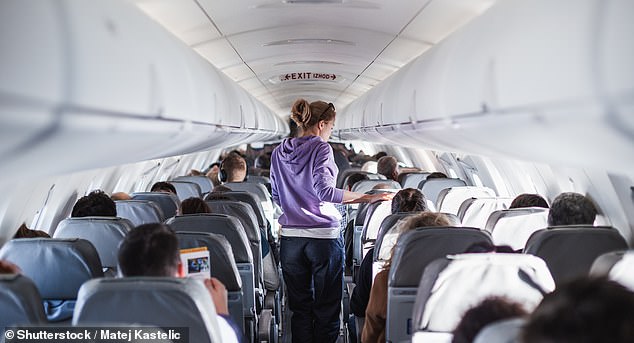[ad_1]
It can be difficult to get comfortable during plane journeys. With small seats and little leg room there is often not much room for movement.
Many passengers cross their legs on flights, but AXA Health physiotherapist Bethany Tomlinson has warned against the common seating position.
According to research, more than one in 10 adults in the UK experience joint issues.
However, this pain could be worsened by long periods of inactivity sitting on aeroplanes.
Bethany explains the risks that can come with sitting cross-legged during a flight.
She warns: ‘Avoid crossing your legs in your plane seat as this will impact blood flow and increase the risk of developing deep vein thrombosis (DVT).’
Instead, the expert advises keeping legs elevated and choosing different relaxing positions.
‘If there’s a footrest under the seat in front of you, use this to keep your legs slightly elevated,’ she adds.

It can be difficult to get comfortable during plane journeys. With small seats and little leg room there is often not much room for movement

Many passengers cross their legs on flights, but AXA Health physiotherapist Bethany Tomlinson has warned against the common seating position
‘Make sure to relax your shoulders and support your back by sitting back into the plane seat whilst you wait.’
To the millions of Brits jetting off this summer, Bethany urges travellers to prepare for the journey to avoid causing strain on joints.
One in three Brits experience stiffness in their knees, and lack of movement or staying in the same position can only worsen this.
Bethany says: ‘Catching flights this summer could turn into an endurance test for our joints, so prepare for every flight like it could be long-haul.
‘Knowing how to position your body and doing exercises when seated to keep your joints moving is essential.’
Another way to ease joint discomfort is by standing in a certain position, Bethany explains.
She adds: ‘When standing up, shift weight between your feet, keep knees slightly bent and do light stretches to avoid too much pressure on your lower body.’
For longer flights, Bethany shares what routine passengers should keep to in order to ensure their joints are healthy.

One in three Brits experience stiffness in their knees, and lack of movement or staying in the same position can only worsen this

Bethany warns passengers: ‘Avoid crossing your legs in your plane seat as this will impact blood flow and increase the risk of developing deep vein thrombosis (DVT).’
‘Flyers need to move their body every 1-2 hours on flights to keep joints mobilised.
‘Being in the same position for hours can lead to stiff and swollen joints, particularly the knees, ankles and hips.
‘Seated exercises whilst in the air will help boost circulation, and reduce the risk of DVT, a common type of blood clot that can form during long periods of sitting.’
The physiotherapist shared a range of mobilising exercises that passengers can easily do from their plane seat, including neck stretches, shoulder rolls and knee hugs.
[ad_2]
This article was originally published by a www.dailymail.co.uk . Read the Original article here. .

